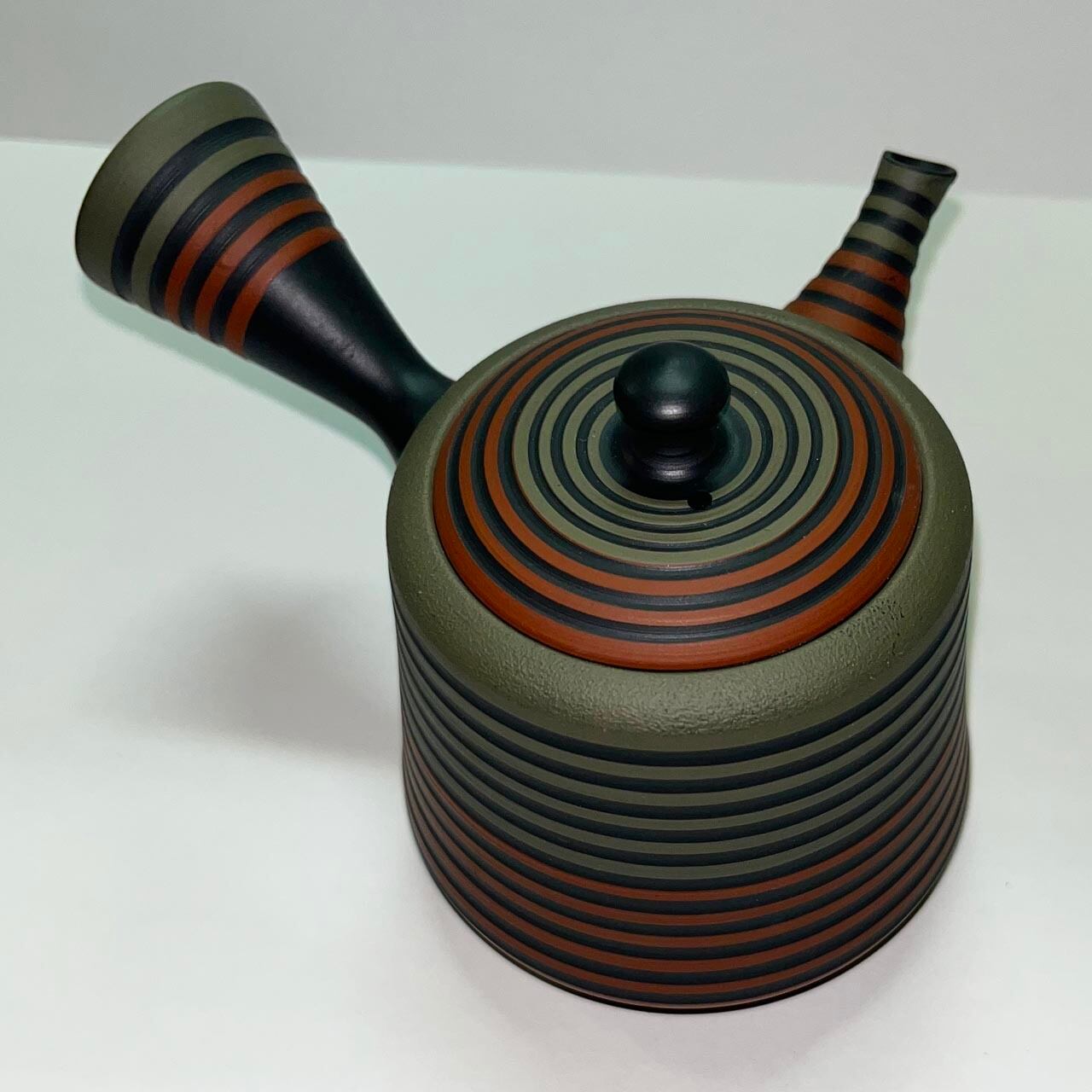








常滑焼 モダンなストライプ柄の手作り急須 宝生庵 高資(磯部輝之)作 箱付き / Tokoname yaki handmade modern striped teapot by Hoshoan Takasuke (Teruyuki Isobe) with original box
¥33,000 税込
SOLD OUT
別途送料がかかります。送料を確認する
この商品は海外配送できる商品です。
美しいストライプ柄が特徴の常滑焼の急須です。日本の伝統技法で作られた宝生庵高資の急須は、上品なデザインと高品質な焼き物が特徴です。
温かなお茶を淹れる際には、この美しい急須を使うことで、いつもの茶の時間が特別なひとときに変わります。お客様をおもてなしする際にも、この急須が上質さと風流な雰囲気を演出します。
宝生庵高資の急須は、職人の手によって一つ一つ丁寧に作られています。素材は特にこだわり、高品質な陶土を使用しているため、長く使用しても色あせることなく美しさを保ちます。
美しいデザインと上質な素材の組み合わせが、これまでの急須とは一線を画す存在感を生み出しています。日本の伝統工芸品をお楽しみいただきながら、ぜひ贅沢なひとときを過ごしてください。
---------------------------------
Q:常滑焼(とこなめやき)とは?
A:常滑焼は、日本の愛知県常滑市を中心とした陶磁器の伝統的な窯元です。「日本六古窯(にほんろっこよう)」(瀬戸・常滑・信楽・丹波・備前・越前)と呼ばれています。平安時代末期には、知多半島の丘陵地に常滑を中心に穴窯が広がり、山茶碗や壺などが作られました。この時代に作られた焼き物は古常滑と呼ばれます。中世常滑窯は当時最大の生産地で、大型の皿や茶碗が特徴でした。室町時代には生産が拡大し、大型の甕や壺が遠隔地へ船で運ばれました。江戸時代には真焼けの陶芸品が増え、明治時代には平地窯や機械化が導入され、食塩焼きが現れ、土管・焼酎瓶・建築陶器、衛生陶器も登場し、近代産業へ進化しました。大正から平成にかけて技術と生産が急速に進歩し、現在の状況に至りました。
Q:宝生庵 高資(ほうしょうあん たかすけ)とは?
A:「宝生庵」は常滑焼の作家、磯部輝之氏の屋号です。磯部氏がかつて勤務された「高資」にいた時に制作されため「高資」の名前も落款として刻まれています。彼の信条は「使う人のくつろぎのひとときをお手伝いしたい」です。そのため、軽くて使いやすく、美しさと実用性、芸術性を兼ね備えた急須を作成しています。色々な作風がある中でも、代表的なものには印花文様があり、そのファンは多くいます。
===================
A Tokoname yaki teapot with a beautiful striped pattern. Teruyuki Isobe's teapots, made with traditional Japanese techniques, feature elegant designs and high-quality pottery.
When brewing hot tea, use this beautiful teapot to turn the usual tea time into a special moment. When entertaining guests, this teapot creates an atmosphere of quality and elegance.
Teruyuki Isobe's teapots are carefully made one by one by craftsmen. We are particular about the materials and use high-quality potter's clay, so it will retain its beauty without fading even after long-term use. The combination of beautiful design and high-quality materials creates a presence that sets it apart from conventional teapots. Please spend a luxurious time while enjoying traditional Japanese crafts.
---------------------------------
Q : What is Tokoname yaki?
A : Tokoname yaki is a traditional pottery pottery centered in Tokoname City, Aichi Prefecture, Japan. At the end of the Heian period (794-1185), anagama kilns spread across the hills of the Chita Peninsula around Tokoname, known as the "Six Ancient Kilns of Japan" (Seto, Tokoname, Shigaraki, Tanba, Bizen, and Echizen). Tea bowls and pots were made. Pottery made in this period is called Ko-Tokoname. Medieval Tokoname kiln was the largest production area at that time, and was characterized by large plates and bowls. During the Muromachi period, production expanded, and large-scale jars and pots could be obtained by ship to remote areas. In the Edo era, the number of ceramics made with true ware increased, and in the Meiji period, flat kilns and mechanization were introduced, salt-grilled products appeared, clay pipes, shochu bottles, architectural ceramics, and sanitary wares appeared, evolving into a modern industry. Technology and production progressed rapidly in the future, leading to the current situation.
Q: What is Hoshoan Takasuke?
A: "Hoshoan" is the trade name of Teruyuki Isobe, a Tokoname yaki artist. Isobe was working at "Takasuke", the name of "Takasuke" is also engraved as a seal. His creed is "I want to help people who use it for a relaxing time". That's why Isobe create teapots that are light, easy to use, and combine beauty, practicality, and artistry. Among the various styles, the representative one is the "Inka" pattern, and there are many fans of it.
-
送料・配送方法について
-
お支払い方法について
¥33,000 税込
SOLD OUT






























